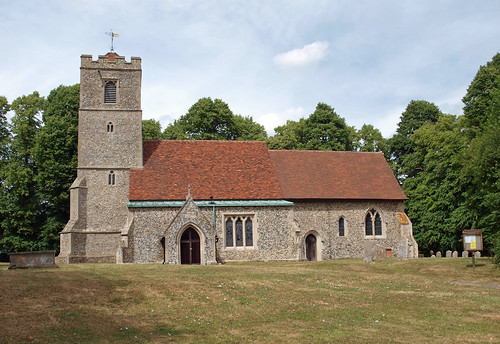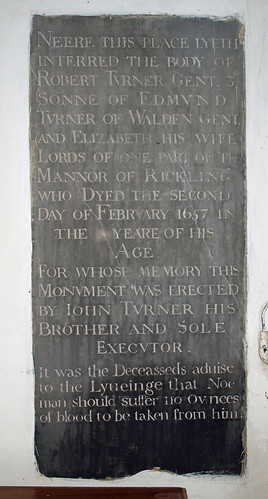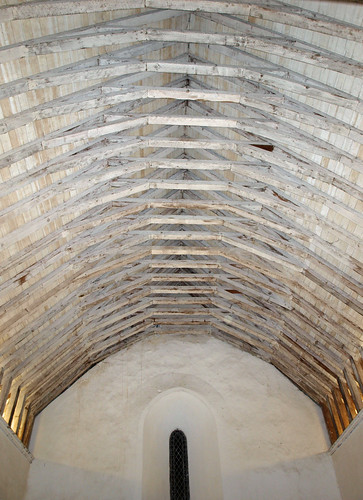All Saints is, reputedly, one of the oldest churches in the area. I don't know about that but I do know that it is one of nicest in the area, the combination of church, large, clear churchyard and its position add up to a perfect exterior.
The unusual size of the nave suggests a pre-Conquest plan; it is possible that worship has taken place here for over a thousand years. The name of the village is found in the Domesday Book (1086) as Richelinnga. It is said to mean Ricela’s or Ricola’s people. Ricola was Queen of Essex in the 6 century.
The earliest remaining part of the present church is the 13th century lancet window in the west wall, which can be seen from the inside of the nave above the tower door.The chancel was added about 1340 (the Early English period) along with the south aisle and tower, the chancel is not quite aligned with the nave. The chancel screen is 14th century. The east window is also 14th century and now contains 19th century glass in memory of General William Inglis, Lord of the Manor. There are three 14th century windows on the south side of the chancel and a doorway of the same date. The doorway into the tower from the nave probably dates from this period. Outside of the chancel door there is a Purbeck marble burial stone for Humfrey Waldene the First, the founder of the present church, dated c.1340.
The pulpit dating from the 15th century is a particularly fine example. The font is octagonal and was made of coarse limestone in the 15th century. It stands on a possibly 14th century base. On the south side of the chancel is a tomb-chest with six quatrefoils with shields, these being the arms of the Langley and allied families, probably 15th century. Rickling Hall, a lovely Tudor brick house, was built to the south of the church around 1500 on the site of a fortified building with two moats.
The upper part of the tower, which has battlements, was added in the 16th century.
The row of lime trees in the churchyard was planted by the vicar in 1836. They were the gift of Lord Braybrooke. There was a large restoration during this century when the vestry, organ chamber and south porch were added. The high altar has a wooden reredos, dating from 1879, and was carved in Belgium. The central panel represents the adoration of the Lamb. All the nave windows and the south doorway are from the19th century. The south window has glass in memory of the rev. John Collin who died in 1887. He was vicar here for 53 years and built the vicarage to the west of the church in 1847. This has been a private house since 1917.
ALL SAINTS. The nave is E.E., as witnessed by one blocked lancet window on the W side. W tower and S aisle were added in the early C14. At the same time the chancel was rebuilt. The W tower has low diagonal buttresses. The top-stage is later with brick quoins and battlements. The chancel windows are typical of their date. So is the arcade of two bays, with a quatre-foil pier and arches of one quadrant and one hollow chamfered moulding. - N recess in the chancel with very low tomb-chest, like a seat, and a big ogee arch. S recess with a tomb-chest with six quatrefoils with shields. - SCREEN. Typical of the C14. The divisions are broad, of four lights separated by shafts with shaftrings, and the tracery is of squashed circles with ogee ending at top and bottom. Finer tracery within these. - PULPIT. C15 with panels with two quatrefoils at the foot (or a wheel of three mouchettes) and blank panel tracery above. - BRASS. Indent under the E arch of the arcade, mostly hidden by the seating. It must have been a very interesting piece; kneeling figure holding a model of a church, early C14.
RICKLING. We come here to see what is left of its Tudor hall,and to admire treasures of old craftsmanship in the church. The hall stands on the site of a Norman castle, and has become a farmhouse with a group of farm buildings. They are set round the sides of a quadrangle, with a gatehouse built early in the Tudor Age. Many of the old windows are left; there is one of the 14th century. A door and a staircase are about 300 years old, and there are massive timbers in some of the roofs. Seventeenth century cottages are grouped round the green, but the church stands apart, near a farm which has a dovecot with more than 400 nesting holes. Except for its Tudor brickwork at the top, the tower is l4th century, and so is most of the church; but the nave has a lancet window suggesting that it was built a century before, and the foundations may be Saxon. There is a l4th century piscina with the remains of a wooden shelf, a 17th century chest still with some of its leather covering, a font of the 14th and 15th centuries, and a splendid modern reredos carved by Flemish craftsmen with saints and angels and evangelists. In the chancel are two handsome arched recesses, one with a marble stone on a 14th century gravestone, the other with a 15th century altar tomb. The shields on the tomb include the Langley arms, and the tomb is said to have been used for the family as late as 1670.
Rickling must be proud of its lovely old screen and pulpit, for both show the splendid art of the medieval workers in wood. The screen is 600 years old and has very beautiful tracery. The octagonal pulpit is a century younger, and has much elaborate ornament.
Simon K -
I turned off on to a steep, steep narrow lane which climbed to the top of the ridge and I was the highest I had been all day. I could see the planes landing and taking off at Stanstead in the valley, some six miles away. The lane spiralled down and there, in the middle of nowhere, was Rickling parish church.
Open. The outer gates latched back, the inner door wedged open. Sometimes you see a church and you just know it is a special place. Here, the pretty little church was in a small graveyard absolutely overcome with daffodils and narcissus - from a distance, it looked like a white and yellow mist.
The setting is very like Belchamp Otten, and the church has similarities. It is such a pleasing, harmonious interior, everything small but in place - the layout is rather like Lindsell. Like Meesden, it felt as if the CCT might be looking after it. A notice by the desk says "If you have visited before, you might notice some things are missing. We had a burglary, and they took all the candelabras from the walls and the pulpit. But we are determined to stay open every day.' God bless them. I don't often put money in the box, but I did here.
I cycled over the next ridge, and after five minutes turned back to look at the church. It was splendid across the rape fields.
Rickling is a joint parish with Quendon. Rickling village is about a mile further on, and on the large village green there was a cricket match in progress, the pub doing good business. It looked idyllic. One of the residents of the village is celebrity chef Jamie Oliver, who grew up in neighbouring Clavering. The road leads down to the A11, the old Norwich and Newmarket to London road, and Rickling becomes Quendon, with bigger houses but much, much more traffic, despite the fact that the M11 also passes through, going under the high street to the north. Madness.
Flickr set.



No comments:
Post a Comment